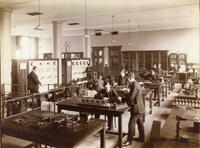 The study of engineering in University College Dublin (UCD) can be traced back to two institutions – UCD and the Royal College of Science for Ireland (RCScI). Both of these developed in turn from mid-nineteenth century institutions led by Cardinal John Henry Newman and Sir Robert Kane, respectively. The photograph shows RCScI students in the electrotechnics laboratory in the College’s premises on Merrion Street in Dublin, opened by King George V in 1911.
The study of engineering in University College Dublin (UCD) can be traced back to two institutions – UCD and the Royal College of Science for Ireland (RCScI). Both of these developed in turn from mid-nineteenth century institutions led by Cardinal John Henry Newman and Sir Robert Kane, respectively. The photograph shows RCScI students in the electrotechnics laboratory in the College’s premises on Merrion Street in Dublin, opened by King George V in 1911.
History of Electrical & Electronic Engineering at UCD
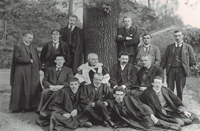 In A Portrait of the Artist as a Young Man, James Joyce drew from his own experience as a student in UCD to describe a lecture on electrical coils: The droning voice of the professor continued to wind itself slowly round and round the coils it spoke of, doubling, trebling, quadrupling its somnolent energy as the coil multiplied its ohms of resistance. The photograph shows students from the BA class of 1902, including James Joyce (standing, second from left) and Felix Hackett, later professor of physics and electrical engineering at UCD (front left). Photograph courtesy of Helen Solterer and UCD Library.
In A Portrait of the Artist as a Young Man, James Joyce drew from his own experience as a student in UCD to describe a lecture on electrical coils: The droning voice of the professor continued to wind itself slowly round and round the coils it spoke of, doubling, trebling, quadrupling its somnolent energy as the coil multiplied its ohms of resistance. The photograph shows students from the BA class of 1902, including James Joyce (standing, second from left) and Felix Hackett, later professor of physics and electrical engineering at UCD (front left). Photograph courtesy of Helen Solterer and UCD Library.
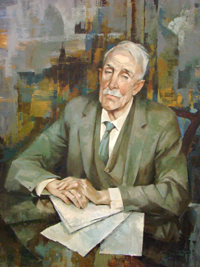 1926 the RCScI merged with UCD, and its flourishing tradition in mechanical and electrical engineering was incorporated in a new Department of Mechanical and Electrical Engineering. Felix E. Hackett (pictured), professor of physics at the RCScI, became professor of physics and electrical engineering in UCD, serving until 1952. Hackett also served as president of the Royal Dublin Society and treasurer of the Royal Irish Academy. Portrait by Muriel Brandt courtesy of the RDS and Gerard Whelan.
1926 the RCScI merged with UCD, and its flourishing tradition in mechanical and electrical engineering was incorporated in a new Department of Mechanical and Electrical Engineering. Felix E. Hackett (pictured), professor of physics at the RCScI, became professor of physics and electrical engineering in UCD, serving until 1952. Hackett also served as president of the Royal Dublin Society and treasurer of the Royal Irish Academy. Portrait by Muriel Brandt courtesy of the RDS and Gerard Whelan.
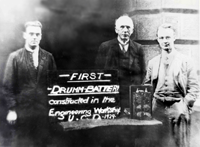 Engineering research and development in UCD at this time was primarily concerned with meeting needs of the fledgling Irish state. The rechargeable battery developed by UCD researcher James Drumm (pictured) was used in railway traction around Dublin from 1932 to 1949. Many UCD graduates, most notably Thomas McLaughlin, participated in the development of the state’s electrical infrastructure, which provided an essential framework for the social, industrial and economic development of the country.
Engineering research and development in UCD at this time was primarily concerned with meeting needs of the fledgling Irish state. The rechargeable battery developed by UCD researcher James Drumm (pictured) was used in railway traction around Dublin from 1932 to 1949. Many UCD graduates, most notably Thomas McLaughlin, participated in the development of the state’s electrical infrastructure, which provided an essential framework for the social, industrial and economic development of the country.
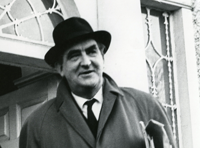 In 1952, Joseph J. Morrissey (pictured) succeeded Felix Hackett as professor of electrical engineering. In 1959, following the separation of the Department of Mechanical and Electrical Engineering into two distinct departments, the first B.E. degrees in electrical engineering were awarded. The first academic computer in the country was installed in UCD in 1962, and later that year UCD and IBM staff collaborated on the country’s first public course in computing.
In 1952, Joseph J. Morrissey (pictured) succeeded Felix Hackett as professor of electrical engineering. In 1959, following the separation of the Department of Mechanical and Electrical Engineering into two distinct departments, the first B.E. degrees in electrical engineering were awarded. The first academic computer in the country was installed in UCD in 1962, and later that year UCD and IBM staff collaborated on the country’s first public course in computing.
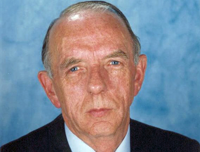 The Department of Electrical Engineering became the Department of Electronic and Electrical Engineering in 1973. The B.E. degree in Electronic Engineering was instituted in 1973, with John O. (Seán) Scanlan (pictured) appointed professor. A world leader in his field of circuit analysis and synthesis, Scanlan also seeded in UCD research activities in digital signal processing, microwave engineering and communications that would develop into major research centres. He is a Life Fellow of the IEEE, Fellow of the IEI, IET and IMA, and served as president of the Royal Irish Academy.
The Department of Electrical Engineering became the Department of Electronic and Electrical Engineering in 1973. The B.E. degree in Electronic Engineering was instituted in 1973, with John O. (Seán) Scanlan (pictured) appointed professor. A world leader in his field of circuit analysis and synthesis, Scanlan also seeded in UCD research activities in digital signal processing, microwave engineering and communications that would develop into major research centres. He is a Life Fellow of the IEEE, Fellow of the IEI, IET and IMA, and served as president of the Royal Irish Academy.
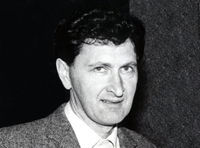 In 1975, Annraoi M. de Paor (pictured) succeeded J. J. Morrissey as professor of electrical engineering. A renowned expert in control theory, de Paor applied ideas from this field to develop important new research activities in biomedical engineering and renewable energy, and also co-founded the centre for disability studies in UCD. He is a Fellow of the IEI, IET and IMA. In addition to his engineering expertise, de Paor is renowned for his love of the Irish language and his contributions to technology education through Irish.
In 1975, Annraoi M. de Paor (pictured) succeeded J. J. Morrissey as professor of electrical engineering. A renowned expert in control theory, de Paor applied ideas from this field to develop important new research activities in biomedical engineering and renewable energy, and also co-founded the centre for disability studies in UCD. He is a Fellow of the IEI, IET and IMA. In addition to his engineering expertise, de Paor is renowned for his love of the Irish language and his contributions to technology education through Irish.
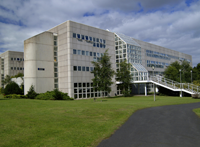 In 1989, the Department of Electronic and Electrical Engineering was relocated to the new Engineering Building located on UCD’s Belfield campus. Research activities in the school grew significantly in scale and in profile, winning major national, international and industrial funding and delivering breakthrough results. A number of successful start-up companies were spun out. In 2002 Thomas J. Brazil succeeded Seán Scanlan as professor of electronic engineering, and in 2005 Mark O’ Malley succeeded Annraoi de Paor as professor of electrical engineering.
In 1989, the Department of Electronic and Electrical Engineering was relocated to the new Engineering Building located on UCD’s Belfield campus. Research activities in the school grew significantly in scale and in profile, winning major national, international and industrial funding and delivering breakthrough results. A number of successful start-up companies were spun out. In 2002 Thomas J. Brazil succeeded Seán Scanlan as professor of electronic engineering, and in 2005 Mark O’ Malley succeeded Annraoi de Paor as professor of electrical engineering.
The School is now led by Professor Peter Kennedy, with Professor Damian Flynn as head of electrical engineering and Professor Peter Kennedy as head of electronic engineering. UCD graduates are represented in key positions in electrical, electronic and communications engineering around the globe, and have led nationally in the development of the renowned technology sector in Ireland and in the country’s innovative electrical energy sector.